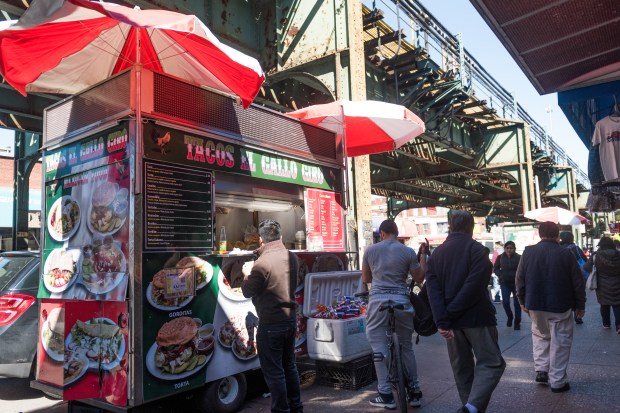Walking down Roosevelt Avenue on the border of Elmhurst and Jackson Heights in Queens, it was easy to miss the inconspicuous gentleman standing on the sidewalk with a covered straw basket perched on a ledge by his side. However, as I glanced in his direction and he said, “tacos?” I was quite certain that he was selling tacos de canasta (also known as tacos al sudados). While New York City is home to many kinds of tacos, this specific type, which translates to “basket tacos” or “sweaty tacos,” is the most elusive. They are traditionally sold on the streets of Mexico and made by piling heated corn tortillas commonly stuffed with pork, beans, or potatoes, in a basket lined with plastic so they continue to “sweat” while being sold. The softened tortillas absorb the fillings and the result is a uniquely satisfying street taco. After purchasing one filled with chicharron, topped off with homemade salsa verde, it was easy to imagine being on the streets of Mexico City.
In New York City, and Queens specifically we are fortunate to have street vendors selling food representative of cultures from around the globe, food that has the ability to momentarily transport you to places such as Xinjiang (while eating cumin- and chili-spiked lamb kebabs from Chinese BBQ carts in Flushing), Cuenca (thanks to hornado and mote choclo sold by Ecuadorean immigrants in Corona), and Tibet (courtesy of the carts and trucks selling piping hot beef momos in Jackson Heights). This is just a small slice of the culinary diversity that food vendors bring to NYC, allowing residents and visitors to experience the world via the 7 train.
Currently, there are an estimated 20,000 street vendors in New York City. Selling everything from sunglasses to falafel; they provide New Yorkers and visitors with everyday essentials and brighten our streets and public spaces. Midtown office workers line up at their daily coffee cart and food adventurers ply the sidewalks in the outer boroughs searching for street food that is representative of the diverse immigrant populations that call this city home.
So what’s the problem? Well, for years street vendors have struggled to do business thanks to strict regulations and harsh enforcement, often the result of intense lobbying by bigger business interests who view vending as archaic and unfair competition. But just ask any street vendor when they last had tables and chairs for their customers, or air conditioning in the summer, and you will understand that this is not about competition. This is about controlling our public spaces and the people and activities that occur in them. Although vendors have been regulated as early as the 1800s, when pushcart peddlers were prohibited from operating for more than 30 minutes in any particular location, the 1970s and 80s brought a wave of harsher regulations that now place considerable barriers to entry for vendors looking to start a small business. Included in these rules are hundreds of street restrictions and numerous sidewalk and street placement constraints that make legal vending locations hard to come by.
The most severe consequence of the lobbying done by the small, but vocal and powerful, anti-vendor lobby was a cap placed, in 1983, on the issuance of food vending permits which are required to sell food in public spaces. Currently, there are only 3,100 permits available for city-wide food vending carts and trucks in New York City (an additional 1,000 are available for the summer season). Prior to the cap, a potential vendor would apply directly to the city for a permit, costing a mere $200, to sell food on the streets and could renew that permit every two years in perpetuity. Since the cap was put in place, demand for permits is at an all-time high. Anyone who wants to be a food vendor must turn to an underground market where prior vendors, who still hold the valuable permits, lease them for upwards of $20,000, for a two-year period. This forces many vendors, who can’t afford the high costs, to work for others rather than have their own businesses.
The lack of available permits prevents vendors from entering the street food market since they often lack the capital necessary to afford the underground market price. It has also resulted in the criminalization of street food and entire communities who rely on vending to support their families. City enforcement officials frequently issue citations to unpermitted vendors with a fine of $1,000 and sometimes make arrests and confiscate, and then destroy, their vending carts.
Thankfully, some relief is on the horizon. The New York City Council has proposed a series of reforms including gradually increasing the number of permits that are available. This package, known as the Street Vendor Modernization Act would be the first step in bringing normalcy to a dysfunctional system where the losers are the vendors and street food fans living and visiting New York. If the reforms are passed, thousands of vendors will be able to work without fear, and finding tacos de canasta on the corner may just be a little easier.
